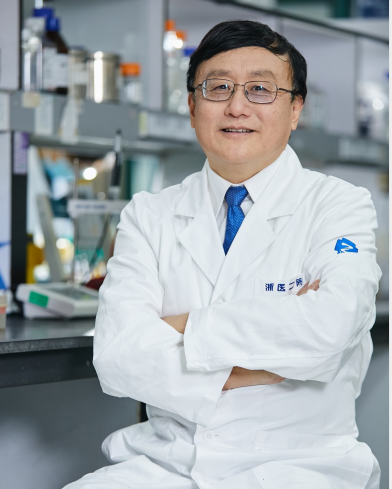

Position:Chair of Cancer Institute
Department:Cancer Institute
Medical School:Harvard T. H. Chan School of Public Health, US
Academic Rank:Professor
Microbiology, virology, tumor immunity.
State Scientific and Technological Progress Award, Second Prize
Natural Science Award of Ministry of Education, First Prize
Commissioner, American Society for Virology, 2003-present
Editor, PLOS One, 2014-present
Editor, Viruses, 2012-present
Chief Editor, Enteroviruses, 2018
Prof. Yu firstly revealed the molecular mechanism of HIV-1 Vif (viral infection factor) protein, which used cellular protein to degrade the natural antiviral factors of host, and provided a new antiviral target for HIV nonstructural proteins, and opened up a new research field of virus defense mechanism against host. As the discoverer of Vpx and Vpr recognized in the International AIDS field, Yu Xiaofang's team took the lead in initiating international research on the mechanism of Vpx and Vpr protein breaking through the host's innate immune defense.
Over the years, Prof. Yu has studied virus replication, especially the molecular mechanism of HIV life cycle and virus pathogenesis. He has published 54 J Virol. articles with more than 4000 citations, including 15 JVI articles with single citation times of more than 100.
Prof. Yu has been engaged in enterovirus research for more than ten years, and published 22 papers on enterovirus, including cell host and microbe, NAR, J. Virol, EMG. Inf. DIS, viruses, etc. He isolated and identified several strains of cv-a16, cv-a6 and ev-a71 of Northeast China. established animal pathogenic model, vaccine strain screening, and worked over immune protection and virus host interaction.
Yajuan Rui, Jiaming Su, Si Shen, Ying Hu, Dingbo Huang, Wenwen Zheng, Meng Lou, Yifei Shi, Meng Wang, Shiqi Chen, Na Zhao, Qi Dong, Yong Cai, Rongzhen Xu, Shu Zheng, Xiao-Fang Yu. Unique and complementary suppression of cGAS-STING and RNA sensing- triggered innate immune responses by SARS-CoV-2 proteins. Signal Transduct Target Ther. 2021 Mar 15;6(1):123. doi: 10.1038/s41392-021-00515-5.
Yuan Gao, Xiao-Fang Yu, Ting Chen. Human endogenous retroviruses in cancer: Expression, regulation and function. Oncol Lett. 2021 Feb;21(2):121. doi: 10.3892/ol.2020.12382. Epub 2020 Dec 17.
Su J, Rui Y, Lou M, Yin L, Xiong H, Zhou Z, Shen S, Chen T, Zhang Z, Zhao N, Zhang W, Cai Y, Markham R, Zheng S, Xu R, Wei W, Yu XF*. HIV-2/SIV Vpx Targets a Novel Functional Domain of STING to Selectively Inhibit cGAS-STING-mediated NF-κB Signalling. Nat Microbiol, 2019 Dec;4(12):2552-2564.
Wu M, Wang G, Hu W, Yao Y, Yu XF*. Emerging roles and therapeutic value of exosomes in cancer metastasis. Mol Cancer. 2019 Mar 30;18(1):53.
Liu Y, Fu Y, Wang Q, Li M, Zhou Z, Dabbagh D, Fu C, Zhang H, Li S, Zhang T, Gong J, Kong X, Zhai W, Su J, Sun J, Zhang Y, Yu XF, Shao Z, Zhou F, Wu Y, Tan X. Proteomic profiling of HIV-1 infection of human CD4+ T cells identifies PSGL-1 as an HIV restriction factor. Nat Microbiol. 2019 May;4(5):813-825.
Li Z, Ning S, Su X, Liu X, Wang H, Liu Y, Zheng W, Zheng B, Yu XF, Zhang W*. Enterovirus 71 antagonizes the inhibition of the host intrinsic antiviral factor A3G. Nucleic Acids Res. 2018 Nov 30;46(21):11514-11527.
Zhao K, Du J, Peng Y, Li P, Wang S, Wang Y, Hou J, Kang J, Zheng W, Hua S, Yu XF*. LINE1 contributes to autoimmunity through both RIG-I- and MDA5-mediated RNA sensing pathways. J Autoimmun. 2018 Mar 7. pii: S0896-8411(17)30780-1.
Li P, Du J, Goodier JL, Hou J, Kang J, Kazazian HH Jr, Zhao K, Yu XF*. Aicardi-Goutières syndrome protein TREX1 suppresses L1 and maintains genome integrity through exonuclease-independent ORF1p depletion. Nucleic Acids Res. 2017 May 5;45(8):4619-4631.
Wei W, Guo H, Chang J, Yu Y, Liu G, Zhang N, Willard SH, Zheng S, Yu XF* ICAM-5/telencephalin is a functional entry receptor for enterovirus D68. Cell Host Microbe. 2016 Nov 9; 20 (5):631-641.
Wei W, Yu XF*. HIV-1 Envelope Under Attack. Trends Microbiol. 2016 Mar;24 (3): 164-6.
Wei W, Yu XF*. HIV-1/HIV-2 versus SAMHD1 restriction: a tale of two viruses. Cell Host Microbe. 2015,14;17(1):8-9.
Zhu CF, Wei W, Peng X, Dong YH, Gong Y, Yu XF*. The mechanism of substrate- controlled allosteric regulation of SAMHD1 activated by GTP. Acta Crystallogr D Biol Crystallogr. 2015, 71(Pt 3):516-24.
Zhu C, Gao W, Zhao K, Qin X, Zhang Y, Peng X, Zhang L, Dong Y, Zhang W, Li P, Wei W, Gong Y, Yu XF*. Structural insight into dGTP-dependent activation of tetrameric SAMHD1 deoxynucleoside triphosphate triphosphohydrolase. Nat.Commun. 2013. 4:2722.
Zhao K, Du J, Han X, Goodier JL, Li P, Zhou X, Wei W, Evans SL, Li L, Zhang W, Cheung LE, Wang G, Kazazian HH Jr, Yu XF*. Modulation of LINE-1 and Alu/SVA Retrotransposition by Aicardi-Goutie`res Syndrome-Related SAMHD1. 2013; Cell Reports, 4, 1108–1115.
Zhang W, Du J, Evans SL, Yu Y, Yu XF*.T-cell differentiation factor CBF-ß regulates HIV-1 Vif-mediated evasion of host restriction. Nature. 2012 ,481(7381): 376-9.
Yu X, Yu Y, Liu B, Luo K, Kong W, Mao P, Yu XF*. Induction of APOBEC3G ubiquitination and degradation by an HIV-1 Vif-Cul5-SCF complex. Science. 2003 .302 (5647):1056-60.
Yu XF, Ito S, Essex M, and Lee TH. A Naturally Immunogenic Virion-Associated Protein Specific for HIV-2 and SIV. Nature 1988,335:262-265.
New mechanism of HIV Vif mediated evasion of host restriction factor. Funding Source: National Natural Science Foundation of China.
The mechanism of SAMHD1 mediated viral and LINE1 inhibition. Funding Source: National Natural Science Foundation of China.
Selective antagonism of coronavirus protein against host innate immunity. Funding Source: National Natural Science Foundation of China.
Research and development of HIV vaccine that can induce effective humoral and cellular immunity. Funding Source: Chinese Ministry of Science and Technology Foundation.
Prevention and control of major infectious diseases such as AIDS and viral hepatitis. Funding Source: Chinese Ministry of Science and Technology Foundation.